Last Updated on March 17, 2023 by Amanda P. Brown
Flatware refers to flat-shaped forks, spoons, knives, and other serving utensils used in eating and dining table setups. On the contrary, Silverware offers the same service but is made of silver metal.
Flatware is very corrosion resistant, durable, and daily use, whereas silverware, is durable but easily eroded, expensive, and unsuitable for daily use.
They both are common dining table wares. But some of the distinct differences between the two in terms of durability, value, material, quality, and specific uses are visual. So, which ware is appropriate depends on the purpose and your requirement.
This article will help you learn about the Flatware Vs Silverware comparison and which is best, including their definition, features, differences, maintenance, etc. So let’s look at the detail below.
What is Flatware?
Table of Contents
Flatware can be defined as “Flat tableware.” And this Flatware refers to the fork, knife, spoon, and other serving utensils that are more or less flat (distinguished from hollowware) used in eating and dining table setup.
Though knives are considered a cutler, sometimes people call some knives like butter knives flatware. In the United States, the term “flatware” refers to all table utensils and is often used to refer to knives.
And this Flatware comes in a variety of materials, such as silver plated, plastic, acrylic, aluminium, stainless steel, and copper. However, the quality of your flatware will change based on the components utilized to make it.
Moreover, you will find it in various designs. In addition, this Flatware contributes to various parts of our daily use, such as school cafeterias, restaurants, social events, and home dining decorations.
Flatware Features
- This Flatware comes in various materials, but among them, Flatware made of stainless steel is often suitable for daily use due to its durability, cost-effectiveness, and easy maintenance.
- Apart from being used as eating and serving utensils, Flatware greatly influences the success of a dining experience.
- It can improve your sense of taste and go well with the décor of your business or household, as well as severely detract from it. The different sizes, weights, shapes, and colors of this Flatware on your table influence food flavors and give you elegant vibes.
- When determining its quality, you should also consider the chromium and nickel levels of a set of Flatware, as these particular metals add shine and improve corrosion resistance. And the ratio of chromium and nickel in stainless steel flatware sets is specified on the label through one of the three ratios: 18/10, 18/8, or 18/0. Before buying, check it out.
Advantages of Flatware
- Strong substance
- Corrosion resistant
- Superior durability
- Scratch resistant
- In comparison to sterling silverware, it is adaptable, shiny, and quite cheaper.
- It can be cleaned easily.
- Ideal for daily use.
Disadvantages of Flatware
- Difficult to repair.
- In exceptional situations, it causes allergic reactions. (Checking the material before buying can make you safe.)
Types of Flatware
You can find many flatware forms (forks, spoons, knives) at your dining table. It’s also worth noting that the materials used to construct them vary. The standard of the flatware is established by the materials used. Below are some different types of Flatware:
1. Stainless Steel
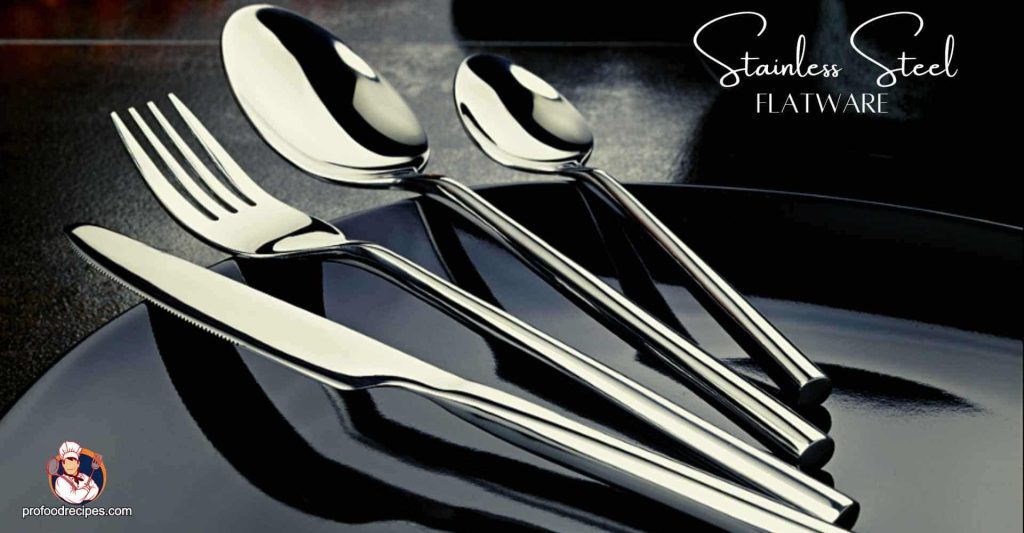
Among the many options for flatware, stainless steel is very popular. As an alternative to table settings, it is quite long-lasting and durable. The amount of nickel and chromium metal used in this Flatware determines the quality rating and makes them durable and long-lasting.
This Flatware contains about 10.5 percent chromium which makes the Flatware durable, and nickel which makes the Flatware resistant to corrosion. So based on this Flatware, there are some grades like 18/10, 18/8, 18/0, and 13/0.
Among these, 18/10 and 18/8 grades are excellent. Even the price depends on the quality of the grade you consider. However, it is durable enough to be cleaned daily by any cleaner and great for daily use.
2. Plastic
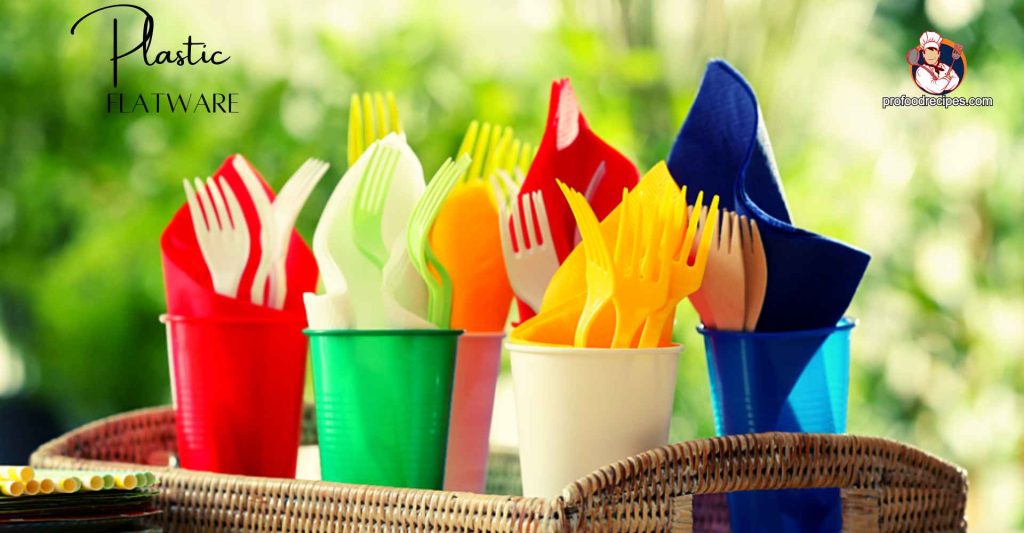
Plastic is best as disposable Flatware. It is available in various coatings, thicknesses, and colors. These colorful and thick plastic flatware are often used in various public events. And being plastic doesn’t always mean cheap and low quality.
You can find different quality levels of this Flatware in the market like premium rose gold plastic flatware, which is a great option for your event within your budget. There is also better quality disposable plastic flatware that you can put on your event, which will impress the guests.
These plastic utensils are safe for use but shouldn’t go in the dishwasher since extreme heat might melt the plastic.
3. Acrylic
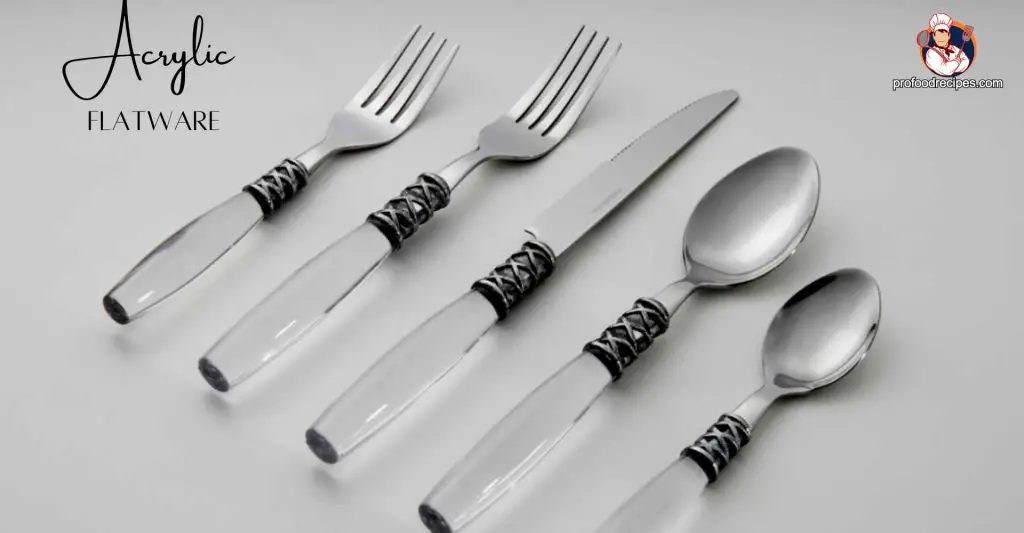
Acrylic Flatware is a great alternative if you are looking for colorful utensils with unique patterns. These cutlery pieces have stainless steel heads and acrylic handles.
The acrylic handles of your cutlery set can be personalized with any design or pattern you choose. Also, it is the best option, especially for formal and informal events. However, you must be careful not to put it in the dishwasher, which may cause the handle design to fade over time.
4. Electroplated

Typically, stainless steel flatware is often electroplated with gold, silver, and copper to add a bit of individuality. During electroplating, the base metal (brass, nickel, stainless steel) is coated with a shiny metal layer. And this metal coating enhances Flatware’s appearance and improves its durability.
It is also widely used on special occasions as electroplated Flatware is cheaper than sterling Silverware. However, with frequent use, the metal coating of electroplated Flatware wears away and exposes the underside.
So to keep the finish intact, you need to take care of the Flatware and avoid using abrasive cleaners. Again some low-quality electroplated utensils are enough to affect the taste of the food, so you have to be careful in your selection.
5. Silver-Plated Flatware

Comparable to other electroplated Flatware, silver-plated utensils have a substrate of nickel, copper, or even another metal coated by a silver coat.
The quality of the Flatware is determined by the coated metal. However, nickel is harder than other materials and adheres well to silver, making it more durable.
In addition, this Flatware is slightly more expensive than stainless steel but has similar durability and exhibits the same feel and beauty as sterling silver. Moreover, it is widely used, especially on special occasions.
What is Silverware?
Silverware is the utensils used in eating, serving, and preparing food, mainly made entirely of silver. Flatware implements such as forks, knives, and spoons can be classified as Silverware if they are made of silver, but not all Silverware is considered Flatware.
This Silverware consists of 92 percent silver, and the remaining 8 percent is classified as other metals, which greatly contribute to making the Silverware more durable. Moreover, compared to other metals, silver essentially destroys bacteria. Typically, this authentic Silverware is referred to as “sterling silverware.” And in terms of price, this sterling Silverware is quite expensive. They are mainly used for formal events.
Silverware Features
- Besides protecting from bacteria, which helps you to stay safe from many diseases.
- This Silverware has a cooling effect which greatly helps improve your metabolism and smooth digestion.
- Due to commercial use, Silverware is not recommended to its high cost and maintenance.
- It can easily get scratched due to a lack of cleaning and maintenance.
Advantages of Silverware
- It possesses anti-bacterial properties.
- Sustainable.
- Valuable metals.
- It has a cooling effect.
- Simple to clean.
- They are good adaptive utensils.
- Easily repairable.
- Permit for intricate designs that greatly enhance the quality of the tools.
- Boosts the immune system.
- Protects food from bacteria.
- Capable of extending the shelf life of perishable items.
Disadvantages of Silverware
- Prone to decay.
- More expensive than stainless steel.
- Easily gets scratched.
Types of Silverware
Since Silverware is primarily a metal made of silver, it does not consist of many variations. So here are 3 types of Silverware that are mentioned:
1. Silver-Plated Tableware
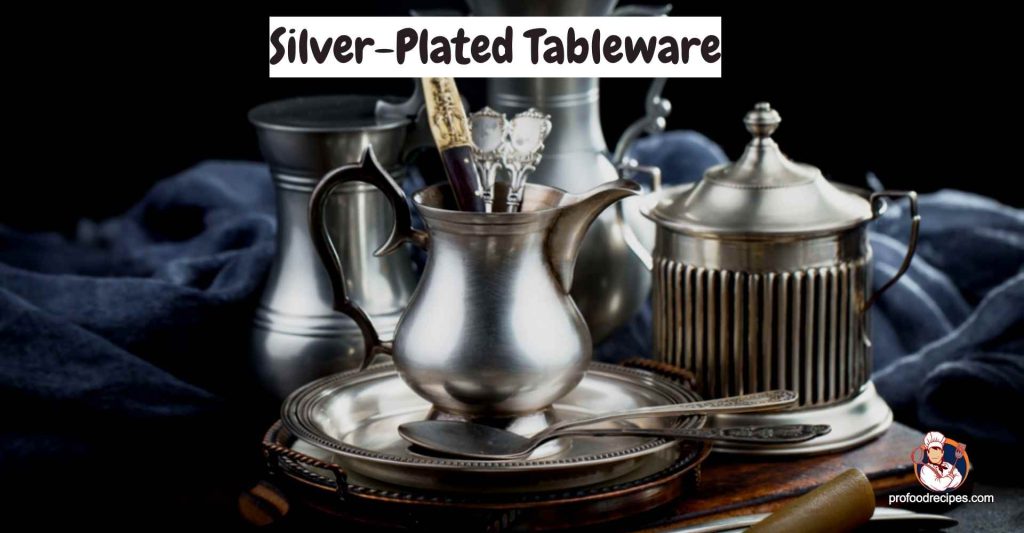
Silver-plated tableware is usually identified as Silverware. Here rather than the metal used, silver coating is primarily visible.
Silver plating is used to cover brass, nickel, and other metals. Therefore, silver-plated utensils still have a high-end silvery appearance despite low silver content. (Compared to Flatware, which is relatively high in Silverware).
Silver-plated Flatware is also great for high-quality table settings, on the other hand. However, silver-plated Flatware tends to be cheaper than stainless steel. But some high-end products cost up to $1,000.
2. Silverware Patterns

This doesn’t refer to particular types of Silverware but instead to the designs incorporated, which determine how elegant or sophisticated the item is designed. For your specific preferences, you have several options, which are listed below;
- Prelude
- Francis I
- Grand Baroque
- Rose Point
- Old Master
- Royal Danish
- Repousse
- Chantilly
Some of these patterns seem more significant since they are either rarer, older, or were once utilized by royalty. Choose whatever you like without worrying too much about what it means.
3. Sterling Silverware
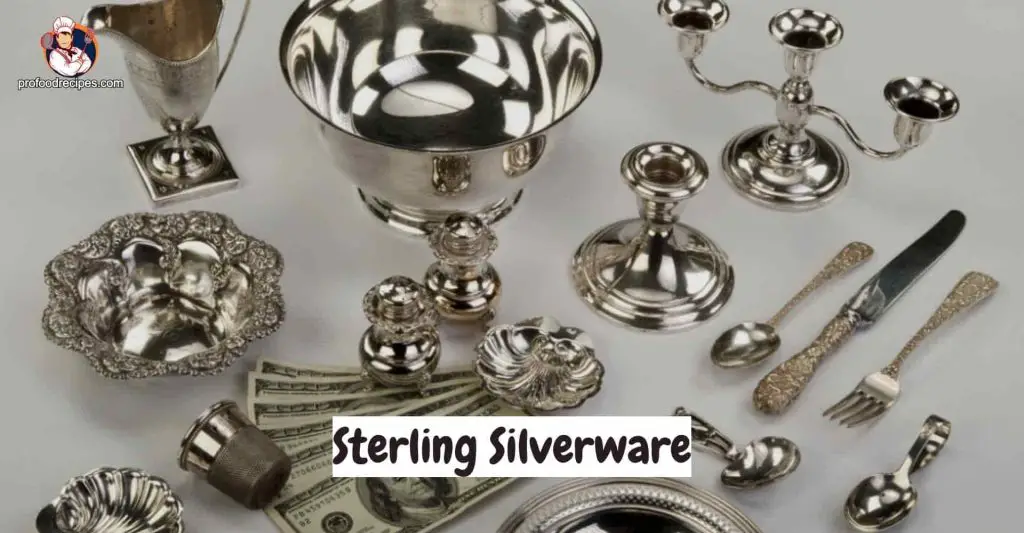
For table settings, sterling Silverware is an ideal option. Sterling is also called silver plated ware, but it consists of 92 to 92.5 percent pure silver, and the remaining 7.5 to 8 percent is made up of other strong metals such as copper and stainless steel.
Solid silver or gold is essentially a soft metal prone to easily deformed. It is not considered suitable to make vessels of solid silver or copper. But careful handling can ensure long-lasting wares.
However, you can take care of the Silverware by polishing it regularly to keep it shiny. You can use a non-corrosive cloth or sponge with mild soap or warm water to clean the water. Also, you should refrain from using it in the dishwasher and wash it as soon as possible.
However, this is the most expensive set, which costs several thousand dollars, i.e., $10,000 per set. Moreover, when not used, sterling silver items for special occasions can be displayed to guests as a form of investment.
Read More: Different Types of Dinnerware and Their Uses with Picture
How do I maintain Flatware and Silverware?
Flatware and Silverware both require maintenance and care for being last longer. Let’s see how you can clean and store Flatware and Silverware individually.
Clean
Cleanliness plays a huge role in keeping your material long-lasting. You can either wash the flatware by hand or put it in the dishwasher when it gets dirty. You should wash your Flatware with a sponge or dishcloth with warm water and mild dish cleaning detergent for hand washing. And for the dishwasher should be taken out before the dry cycle and dried with a soft cloth. And to keep your Flatware shiny, polish it once or twice a year.
In the case of Silverware, you can’t let the food sit in the container for too long after use as there is a chance of rusting. So, rapidly washing it off is required.
However, silver, a precious and soft metal, can get scratched easily, so it should be washed by hand and not using an abrasive sponge. And you should clean it with mild dish soap, excluding high-chemical products that won’t damage the wares. After cleaning, you should wipe with a soft cloth to prevent water stains.
Storage
For storage of your Flatware and Silverware, allocate a clean, dry, and cool environment away from moisture and grease because Silverware gets tarnished when it comes in contact with oxygen and sulfur in the air.
And keep your Silverware in an acid-free tissue paper-wrapped, dry, cotton, or turn-proof bag. You should also keep Silverware away from household paint, newspaper, smoke, felt or velvet, rubber, and wool.
What is the Difference Between Flatware and Silverware?
Both Flatware and Silverware have some matches and mismatches. You can determine the differences between them in terms of durability, value, material, and quality. In this regard, the table below will help you compare these wares.
Flatware Vs Silverware
| Factors | Flatware | Silverware |
| Definition | A meal is served with flatware, which includes cutlery like spoons, knives, and forks. | Silverware refers to utensils such as forks, spoons, and knives covered by silver. |
| Cost | Flatware is cost-effective compared to Silverware. | Silverware is quite expensive compared to Flatware. |
| Classification | Flatware can be classified as Silverware because many flatwares are silver-plated. | On the other hand, not all Silverware can be classified as Flatware. |
| Materials | Flatware comes in various materials, but acrylic and plastic are the cheapest. | And Silverware is only made of silver. The strength of the silver vessel is improved by combining it with stronger metals. |
| Dishwasher-safety | Flatware is scratch resistant, so it is dishwasher safe. | Silverware is not scratch resistant, so it is unsafe in the dishwasher. Because silver is a soft metal, when placed in the dishwasher, it is prone to scratches and cracks. |
| Cleaning and maintenance | It’s simple to keep clean and in good condition. | Require more care and frequent cleaning after use. |
| Appearance | Gold and copper flatware is an excellent option among Flatware to make your dining impressive to your guests with golden sparkles. | Silverware is a great option for your dining room in terms of elegance, pattern, and style. |
| Corrosion tendency | Flatware has less corrosion tendency than Silverware. | Silverware has a higher corrosion tendency than Flatware |
| Bacteria protection | Flatware does not protect food from bacteria like Silverware but can cause allergic reactions in exceptional circumstances. | Silverware being a precious metal protects food from bacteria. |
| Longevity | As a high-quality flatware, 18/10 stainless steel flatware is very durable and corrosion-resistant. At least 2 to 3, it can easily stay. | For high-quality Silverware, 18/10 and 18/0 protect against corrosion from stainless steel and those sensitive to nickel. Moreover, the Silverware 18/10 will last longer than the 18/0. |
| Daily use | Appropriate for daily use. | Silverware is mainly suitable for formal events. |
Read More: What is the Difference Between Earthenware and Stoneware?
Which is Best, Flatware or Silverware?
Flatware and sterling Silverware have almost the same functions and features, but each has unique qualities that make them special. So, it’s quite confusing about which one will be the most suitable for you. But one thing is that it depends on your essential needs.
So, if you’re looking for something long-lasting, affordable, scratch and corrosion-resistant, and great for everyday use without any appearance concerns, Flatware is great.
On the other hand, if you want something with highly precious metal that is quite elegant, can hold enough shape for various intricate designs, and for special occasion use or decoration, then Silverware is one of the best options.
So on this basis, just pick one that can deal with your demand properly.
How Many Pieces Are in a Set of Flatware?
Typically, a modern flatware set consists of 4 to 6-place settings with five different utensils with each one. Each place setting comes with basic cutlery for one diner, including a salad/dessert fork, a dinner knife and fork, a soup/cereal spoon, and a soup/cereal spoon.
How Many Pieces Are in a Set of Silverware?
Like flatware sets, each table set includes 5 pieces of silverware sets such as a salad fork, teaspoon, dinner knife, tablespoon, and dinner fork. Additionally, some larger sets will come with serving utensils and a set of steak knives that are specially made for the table. This silverware set is used in many formal dining settings.
Final Verdict
The above article about Flatware Vs Silverware will help you to find the right one. Your using purpose and the comparison of Flatware Vs Silverware, their features, definition, pros-cons – all will lead you to your appropriate ware choosing.
So if you are looking for corrosion-resistant, affordable, and daily-use ware, Flatware is one of the great options. On the other hand, if you want a precious metal, durable, anti-bacterial property container that is a great choice for special occasions, then Silverware is great.
You May Also Like to Read:
- Carbon Steel Vs. Stainless Steel Pan
- Wok VS Frying Pan
- Gas Vs Electric Smoker
- Juicer Vs Blender Vs Food Processor
- What is the Safest Cookware?
